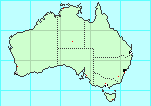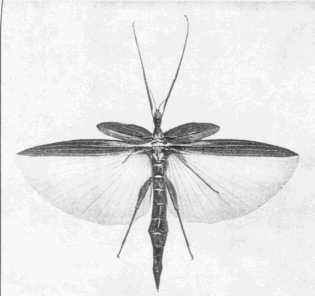Common Names:
Children's Stick Insect
Yellow-winged Spectre
Identification:
Length:
Coloring:
Note any distinguishing features.
volant; male and female macropterous
The four posterior [legs] have their thighs dilated outwardly and
serrated, but all are of a glaucous colour; the mesothorax is somewhat
triangular in form, and keeled down the centre, with the sides sloping,
and the outer margins serrated; the wings hyaline, tinged with yellow;
the costal area is much broader near the centre than at the tip, and is of
a dark green, with the part near the base yellow, while the base itself
is violet; the tegmina are of a dark green, ridged in the centre; the
abdomen is yellow, with the margin on the sides, the hypopygium or last
ventral segment, and the leaflets dark green; the latter are very short.
(from
Gray, 1933)
lives high
in eucalypts, where it relies on its behaviour and morphology to protect
it from potential predators. At certain times of the year it is fairly
active, and is occasionally found at porch lights. If it is disturbed,
the hind legs are quickly lifted and struck together repeatedly, and
the tegmina and wings are beaten up and down rapidily in a fluttering
motion, at the same time displaying the blue blotches at their base,
while the body is moved vigorously between the fore and middle legs,
causing the vegetation to shuffle and wave. The insect does not move
away from the source of the disturbance.
Note parental placement of eggs.
Note appearance of eggs.
Note any common variations.
Habitat:
arborial.
Canopy, mid, under, etc.
Note typical vegetation, e.g.
tropical rainforest, temperate rainforest,
grasslands,
alpine, etc.
Similar Species:
Rearing Notes:
Note if this species has ever been reared.
Note any suggestions for successful rearing.
PSG notes indicate the following foodplants have been used successfully
in captivity: Eucalyptus.
For a stick insect with body length 138mm, to keep 2 adult females,
you need a cage at least 650mm high, 300mm deep and 300mm wide.
 Range:
Range:
NE coastal, SE coastal, QLD, NSW, VIC
Status:
It is not known if this species is endangered,
as there is insufficient sighting history.
References
-
Balderson, J., Rentz,
D.C.F. and Roach, A.M.E. (1998).
in
Houston, W.K.K. & Wells, A. (1998) (eds)
Zoological Catalogue of Australia.
Vol. 23.
Archaeognatha, Zygentoma, Blattodea, Isoptera, Mantodea, Dermaptera,
Phasmatodea, Embioptera, Zoraptera.
Melbourne: CSIRO Publishing, Australia (ISBN 0643 06035 9).
pp. 347 - 376.
-
Bedford, G.O. & Chinnick, L.J. (1966).
Conspicuous displays in two species of Australian stick insects.
Anim. Behav., 14: 518-521
-
Bedford, G.O. (1968).
Notes on the biology of some Australian stick insects (Phasmatodea),
Journal of the Australian Entomological Society,
7: 81-82
-
Bedford, G.O. (1975).
Defensive behaviour of the New Guinea stick insect Eurycantha
(Phasmatodea: Phasmatidae: Eurycanthinae).
Proceedings of the Linnean Society of New South Wales
100: 218-222
-
Bedford, G.O. (1978).
Biology and ecology of the Phasmatodea.
Ann. Rev. Entomol. 23: 125-149
-
Bradley, J.C., and Galil, B.S. (1977).
The taxonomic arrangement of the Phasmatodea with keys to the subfamilies
and tribes.
Proceedings of the Entomological Society of Washington,
79(2): 176-208.
-
Brock, P.D. (1999).
Review, Zoological Catalogue of Australia.
Bulletin of the Amateur Entomological Society,
58: 177-178.
-
Campbell, K. G., Hadlington, P., 1967.
The biology of the three species of phasmatids which occur in
plague numbers in forests of south eastern Australia.
Forestry Commission NSW Res. Note No. 20, 38 pp.
-
Clark, J.T. (1976).
The eggs of stick insects (Phasmida): a review with
descriptions of the eggs of eleven species.
Syst. Ent. 1: 95-105.
-
Gray, G.R. (1833).
The Entomology of Australia in a Series of Monographs. Part 1.
The monograph of the genus Phasma.
London: Longman & Co. 28 pp. 8 pls
-
Gray, G.R. (1835).
‘Synopsis of the Species of Insects Belonging to
the Family of Phasmidae.’ 48pp.
(Longman, Rees, Orme, Brown, Green and Longman: London.)
-
Heather, N.W. (1965).
Studies on female genitalia of Queensland Phasmida,
Journal of the Entomological Society of Queensland,
4: 33-38.
-
Key, K.H.L. (1970).
Phasmatodea (Stick-insects). pp. 394-404 in CSIRO (ed.) The
Insects of Australia. A textbook for students and research workers.
Melbourne: Melbourne University Press, Vol. 1, 1st Edn.
-
Lea, A.M. (1923).
A large South Australian insect.
South Australian Naturalist, 1923: 104, Fig. 2.
-
Musgrave, A. (1922).
Stick and Leaf Insects,
Australian Museum Magazine,
October, 1922, pp. 171-181
-
Rainbow, W.J. (1897).
Catalogue of the described Phasmidae of Australia.
Records of the Australian Museum, 3(2), 37-44.
[Note that he made a mistake re Extatosoma popa and E. tiaratum
according to
Gurney, A.B. (1947).
Notes on some remarkable Australasian walkingsticks, including a
synopsis of the Genus Extatosoma (Orthoptera: Phasmatidae).
Annals of the Entomological Society of America. 40(3): 373-396.
.]
-
Rentz, D.C.F (1996).
Grasshopper Country,
Chapter 16,
Phasmatodea: Leaf and Stick Insects,
pp. 244-257
-
Tepper, J.G.O. (1902).
List of the Described Genera and Species of the Australian and Polynesian
Phasmidæ (Spectre-Insects).
Transactions of the Royal Society of South Australia, 26: 278-287.
-
Vickery, V.R. (1983).
Catalogue of Australian stick insects (Phasmida,
Phasmatodea, Phasmatoptera, or Cheleutoptera). CSIRO
Australian Division of Entomology Technical Paper, No. 20, 15 pp.
- Search Google for
Tropidoderus childrenii,
or search Google Scholar for
Tropidoderus childrenii.
Phasmid Study Group
This is PSG species 193.
Synonyms:
Copyright © 2000-2003
Peter Miller
This page was last changed 20-Sep-2006.
|

|

|




 Range:
Range: 
